
Maianthemum dilatatum is a common rhizomatous perennial flowering plant that is native to western North America from northern California to the Aleutian islands, and Asia across the Kamchatka Peninsula, Japan, and Korea. It grows in coastal temperate rainforests, and is often the dominant groundcover plant in Sitka Spruce forests.

Rudbeckia laciniata, the cutleaf coneflower, is a species of flowering plant in the family Asteraceae. It is native to North America, where it is widespread in both Canada and the United States. Its natural habitat is wet sites in flood plains, along stream banks, and in moist forests. Common names other than cutleaf coneflower include cutleaf, goldenglow, green-headed coneflower, tall coneflower, sochan and thimbleweed.
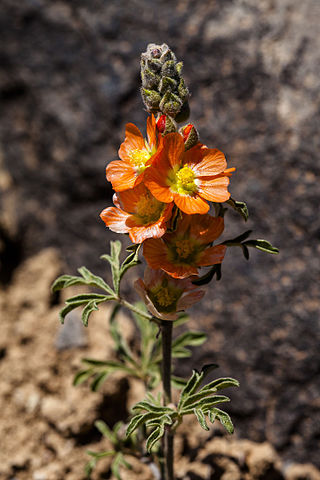
Sphaeralcea coccinea, commonly known as the scarlet globemallow, cowboy's delight, prairie mallow, red false mallow, or simply as globe mallow is a perennial plant growing 10–30 cm tall from spreading rhizomes with a low habit. They have grayish stems with dense, star-shaped hairs and alternately arranged leaves. The leaf blades are 2–5 cm long, palmately shaped, and deeply cut, with 3–5 main wedge-shaped segments. The undersides of the leaves have gray hairs. The 2-cm-wide flowers are reddish-orange and saucer-shaped, with 5 notched, broad petals, in small terminal clusters. Plants flower from May to October.

Neogaerrhinum filipes, synonym Antirrhinum filipes, is an annual species of North American flowering plant in the family Plantaginaceae. It is known by the common name yellow twining snapdragon. This herbaceous plant is native to deserts of the southwestern United States and northern Mexico, where it is common.

Dysphania multifida is a species of flowering plant in the family Amaranthaceae known by the common names cutleaf goosefoot and scented goosefoot.

Lythrum portula is a species of flowering plant in the loosestrife family known by the common names water-purslane and spatulaleaf loosestrife. It is native to Europe, and it is found in parts of western North America as an introduced species. It often grows in moist habitat, such as marshes.
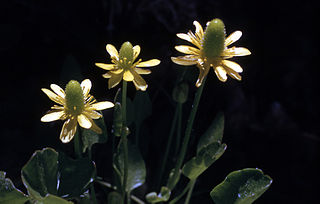
Halerpestes cymbalaria is a species of buttercup known by the common names alkali buttercup and seaside buttercup. It is native to much of Eurasia and parts of North and South America, where it grows in many types of habitat, especially in moist to wet areas such as marshes, bogs, and moist spring meadows. It is a perennial herb producing several stems a few centimeters to nearly 40 centimeters long. Some are prostrate against the ground and are stolons which root in moist substrate, and some are erect. The leaves are variable in shape, the basal ones with notched or slightly divided leaf blades borne on long petioles, and any upper leaves much reduced in size. The inflorescence bears one or more flowers on erect stalks. The flower has five to eight pale yellow petals, each under a centimeter long. The protruding receptacle at the center of the flower becomes a cylindrical cluster of fruits, each of which is an achene.

Ranunculus hebecarpus is a species of buttercup known by the common name delicate buttercup. It is native to western North America, including several of the western United States and Baja California, where it grows in grassland, woodland, and chaparral habitat. It is an annual herb producing a slender, hairy stem a few centimeters high or up to 30 centimeters tall. The hairy leaves are borne on long petioles. Their blades are deeply lobed or divided into three leaflets, often with toothed or lobed edges. Flowers have 3 to 5 tiny yellow petals just 1 or 2 millimeters long studded on the bulbous nectary; some flowers lack petals. The plant is most easily identified in its fruiting stage, when the infructescence is a spherical cluster of several tiny disc-shaped achenes with compressed, bristly sides.
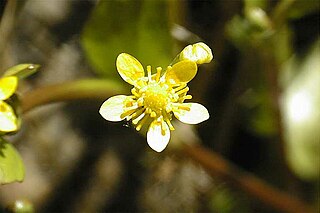
Ranunculus hydrocharoides is a species of buttercup known by the common names frogbit buttercup, or frog's-bit buttercup. It is native to western North America, including the southwestern United States and Mexico. It is also known from Guatemala. It is aquatic or semi-aquatic, growing floating in water or in wet land near water. Typical habitat includes marshes, streams, and lakes. Stems are up to 25 centimeters long, prostrate on the ground when terrestrial, or floating when aquatic. The shiny green leaves have heart-shaped or oval blades up to 3 centimeters long which are borne on petioles which may be 15 centimeters in length. Flowers have 5 to 8 shiny yellow petals a few millimeters long with many stamens and pistils at the center. The fruit is an achene borne in a spherical cluster of 9 or more.
Ranunculus lobbii is a species of buttercup known by the common name Lobb's buttercup, or Lobb's aquatic buttercup. It is native to a few areas in western North America, where it is reported from British Columbia, Oregon, and northern California. It is an aquatic plant, growing in various types of shallow-water habitat, including forest ponds and vernal pools. It is an annual herb producing submerged stems 20 to 80 centimeters long which may float at the surface. The blades of the leaves are tiny and divided into threadlike segments. If any leaves develop on stem parts which are exposed to air they are much different in morphology, developing larger, more robust leaves. Flowers have generally 5 petals which are white in color and about half a centimeter long. Many stamens and pistils fill the center of the flower. The fruit is an achene borne in a spherical cluster.
Ranunculus orthorhynchus is a species of buttercup known by the common name straightbeak buttercup. It is native to western North America from Alaska to California to Utah, where it grows in moist areas in many types of habitat, including meadows and marshes.

Ranunculus parviflorus is a species of buttercup known by the common name smallflower buttercup. It is native to Europe, but it is known on other areas of the world as an introduced species and sometimes a roadside weed, for example, in parts of Australia and the United States.

Ranunculus uncinatus is a species of buttercup known by the common names woodland buttercup and little buttercup. It is native to western North America from Alaska to California to New Mexico, where it grows in wet, wooded habitat such as forest streambanks.

Scrophularia lanceolata is a species of flowering plant in the figwort family known by the common names lanceleaf figwort and American figwort. It is native to North America, where it is known from western and eastern Canada and much of the United States except for the southeastern quadrant. Past common names include Western figwort when the western US plants were grouped under the name Scrophularia occidentalis and the eastern US plants were called Scrophularia leporella with the common name hare figwort.

Acleisanthes nevadensis is a species of flowering plant in the four o'clock family known by the common names desert moonpod and desert wing-fruit. It is native to a section of the southwestern United States encompassing southern Nevada and adjacent corners of Utah and Arizona. One occurrence has been observed in eastern California. The plant grows in desert habitat such as scrub and rocky washes. This herb produces several spreading stems up to about 30 centimeters in maximum length, sometimes from a woody base. The stems are covered in many leaves with fleshy oval or rounded blades up to 3 centimeters long which are borne on petioles. The herbage of the plant is coated in thick, wide, white, furry hairs, interspersed with shorter, flat hairs. Some hairs are glandular. Flowers occur in leaf axils. Each is a trumpet-shaped bloom with a narrow, tubular green throat up to 4 centimeters long and a round white corolla face about a centimeter wide, sometimes tinged yellow or greenish. There are five long, protruding stamens and a long style tipped with a spherical stigma. The fruit is a ribbed, hairy body with five broad, white wings.
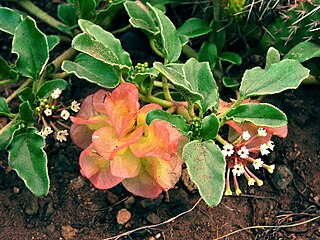
Tripterocalyx micranthus is a species of flowering plant in the four o'clock family known by the common names smallflower sandverbena and small-flowered sand-verbena.

Triteleia hyacinthina is a species of flowering plant known by the common names white brodiaea, white tripletlily, hyacinth brodiaea, and fool's onion. It is native to western North America from British Columbia to Idaho to central California. Its habitat includes grassland and vernally moist areas such as meadows and vernal pools. It is a perennial herb growing from a corm. It produces two or three basal leaves up to 40 centimeters (16 in) long by 2 centimeters (0.79 in) wide. The inflorescence arises on an erect stem up to 60 centimeters (24 in) tall and bears an umbel-like cluster of many flowers. Each flower is a funnel-shaped bloom borne on a pedicel up to 5 centimeters (2.0 in) long. The flower is white, often tinged purple along the tubular throat, with six green-veined tepals. There are six stamens with white, yellow, or occasionally blue anthers.
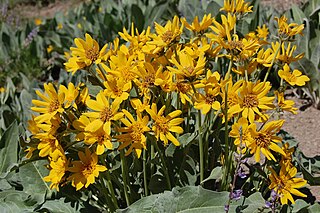
Wyethia mollis is a species of flowering plant in the family Asteraceae known by the common name woolly mule's ears. The plant is hairy to woolly in texture, sometimes losing its hairs with age.
Agave phillipsiana is a rare species of flowering plant in the asparagus family known by the common names Grand Canyon century plant and Phillips agave. It is endemic to Arizona in the United States, where it lives only in Grand Canyon National Park. It is a perennial herb or shrub.

Ceanothus herbaceus, also known as Jersey tea, is a species of shrub in the family Rhamnaceae and is similar to Ceanothus americanus and Ceanothus sanguineus. It is a perennial shrub which is native to North America.


















